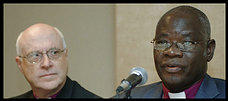All Hail the Akinola Communion

Consider the myriad machinations of our Anglican right in the AAC, the ACN, the IRD, etc. Recall their manipulations in darkness, their deceptive fronts, their sustained calculations aimed at achieving a permanent schism within ECUSA—could it all have as its crowning achievement the comic coronation of the very, very, very reverend Akinola? The blind leading the blind. One should prefer Griswold to Akinola, hands down—there is simply no question for any faithful Christian. Just look at the theology of Christian Believing and The Anglican Vision—not perfect by any means, not even my preferred framework, but impressive nonetheless, cogent, Scriptural while being traditional and yet modern, brilliant and faithful. The North American Anglican right, agitating in the shadows for schism while nursing its Precious, its special sense of paranoia and persecution, has finally taken leave of its senses.
It seemed to me a while ago that Kierkegaard’s category of the aesthetic applied well to Bishop Iker’s live performance (see the comments); now it seems to me that it applies much more widely across the North American Anglican right. It will take a miracle to bring them back to the Cross, which is to say, of course, that it is entirely possible though out of our hands.
It seems to me—and I may well be wrong, indeed I hope that I am wrong on this—that large numbers of Anglican wingers have adopted a peculiar hermeneutic, have put in a certain pair of lenses with which to look out at the world—and finally forgotten that the lenses were in. They started playing a game of pretend, and have played it for so long that they have come to take the game for reality.
Almost everything ECUSA’s leadership does, nearly whatever comes out of 815, whenever someone from ECUSA slips up and makes a mistake in word or deed--it is interpreted so as to fit a preconceived narrative, and the apparent experience of “fit” is taken to validate their twisted interpretation. Anglican wingers compile huge and growing lists of outrages from ECUSA, these outrages functioning like bricks enclosing them within high and growing walls, protected from disconfirmation or dissonant interpretations.
Just as Iker knew in his heart—I believe—that ECUSA really was not fascist, and just as Turner knew in his heart that ECUSA’s working theology as preached was not really vacuous, so the Anglican right at some point knew that its hermeneutic distorted what was really going on; reality was more complex, ambiguous, ambivalent. Reality would not be sufficient to motivate an effective schism—and indeed, the Anglican right suffered defeat after defeat in the US, unable to unite for schism or to roll back the left; they grew in desperation. Just as Bush needed the fiction of WMDs for invading Iraq, the Anglican right needs the fiction of ECUSA-in-Apostasy for finally achieving schism. But just as with Bush, it appears the Anglican right has actually started to believe its lies. Their warped hermeneutic became their Precious, the one thing that could, as a means to power, Rule them all and in the Darkness Bind Them. Never mind that they risk morphing from Sméagol to Gollum. In short, I fear it is too late: the right’s long, impassioned intercourse with the Power of the Abyss—there can only be one father of lies—has borne fruit that may soon become visible to all. But we simply must see to it with God’s help that their fornication is and remains vain, that it really turns out to be all for nothing. Let them have the Akinola Communion for which they have worked so hard and so long, provided Anglicanism goes on.
Provided Anglicanism goes on? What do I mean by "Anglicanism"? That is what I am working out by going through Christian Believing and The Anglican Vision; we in ECUSA and (what looks like it will be) the faithful remnant of the Anglican Communion still have an essential contribution to make to Christianity. It is no surprise that so many Anglican wingers prefer the broad and easy path of immoral conformity opened to them by the spirit ruling this age--but despite their numbers (and Truth is not to be settled by a majority or even a supermajority) that spirit and its age are already doomed. Resistance to the everlasting Gospel of Christ is to be expected, both here in the US and from other quarters worldwide. Our task is to remain faithful to the Gospel Christ has revealed and to redouble our commitment to evangelism; by all indications a vast new mission field in crying need of Christ's love is about to open.

